What Critical Race Theory
is the first topic in the Project 21 series:
WHAT IT MEANS FOR BLACK AMERICA
Written by Project 21 Co-Chairmen
HORACE COOPER | STACY WASHINGTON | COUNCIL NEDD II
Project 21 is a division of the NATIONAL CENTER FOR PUBLIC POLICY RESEARCH, a non-profit, non-partisan educational foundation based in Washington, D.C.
PROJECT 21 • WHO WE ARE
Project 21 is an initiative of the National Center for Public Policy Research launched in 1992 to promote conservative and libertarian black leaders in the media so that news coverage better reflects the true diversity of thought within the black community.
Project 21 members have been interviewed over 50,000 times — currently averaging more than two television interviews each day — appearing on FNC, CNN, C-SPAN, MSNBC, NewsMax and OANN. In addition, Project 21 members are interviewed on radio an average of nearly 1.5 times per day and have appeared on major radio stations and shows such as the Rush Limbaugh Show, Sean Hannity and Jim Bohannon. Members are also frequently published and quoted in newspapers, including the New York Times, Wall Street Journal, Washington Post, Washington Times, Detroit News, Houston Chronicle and many others.
Project 21 members come from all walks of life and from all over the country. Its membership includes members of the clergy, business leaders, entertainers, athletes, economists, journalists, attorneys and students.
What Project 21 members have in common is a desire to make America a better place for black Americans — and all Americans — to live and work.
They do so not only by writing op-eds and participating in radio and TV interviews on the most important issues of the day, but also by advancing a positive vision for improving the lives of black Americans. Project 21 publishes the “Blueprint for a Better Deal,” a series of publications offering specific policy recommendations for helping black America reach its full potential. Notably these recommendations build on key aspects of Americanism — free enterprise, personal responsibility and limited government — and consequently would result in benefits for the country, not just blacks. It also publishes the “What it Means for Black America” series of monographs that assess policy initiatives for their specific impact on people of color.
Project 21 members also give speeches before student, community, business and religious groups; testify before Congress and other government bodies; advise policymakers at the national, state and local level and file public comments on federal rulemakings.
PROJECT 21 • LEADERSHIP
CO-CHAIRMEN
HORACE COOPER
In addition to co-chairing Project 21, Horace Cooper is a senior fellow and member of the board of directors of the National Center for Public Policy Research. He previously served as deputy director of Voice of America, chief of staff at the U.S. Department of Labor and was a senior aide to the leadership of the U.S. House of Representatives. He also taught constitutional law at George Mason University School of Law. He is the author of “How Trump is Making Black America Great Again.” He appears regularly on the Fox News Channel and talk radio shows across the nation as a legal and political commentator.
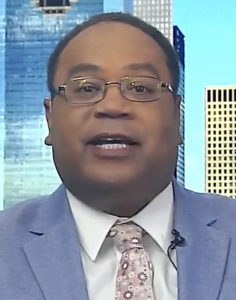
STACY WASHINGTON
Stacy Washington is host of “Stacy on the Right” on SiriusXM satellite radio. She authored the upcoming book “Eternally Cancel Proof – A Guide for Courageous Christians Navigating the Political Battlefront.” She is an Emmy-nominated TV personality, and a veteran of the U.S. Air Force. She is also a former elected school board member in Missouri. During the 2020 presidential campaign, she co-chaired Black Voices for Trump and Veterans for Trump. Stacy is a regular guest on Newsmax, the Fox News Channel on talk radio. An avid defender of gun rights, she was named the 2nd Amendment Foundation’s Journalist of the Year and was featured on the cover of NRA’s America’s First Freedom magazine.

BISHOP COUNCIL NEDD II
The Right Reverend Council Nedd II, Ph.D. serves as Rector of St. Alban’s Anglican Church in Pine Grove Mills, Pennsylvania and is a Pennsylvania State Constable for Ferguson Township. He is the author of several books, including “Does America Hate God? Faith Under Fire” and “Teach Me How to Pray: A Guide to Family Prayer.” Council was consecrated as the Bishop of the Chesapeake in 2005. He was named “Constable/Marshall of the Year” by the National Constable and Marshalls Association in 2021. He previously worked on political campaigns, as a congressional staffer and is a former history teacher in a Washington, D.C. charter school.

What Critical Race Theory
Means for Black America
Within a remarkably short period of time, a once-obscure academic doctrine has emerged to roil American society in a manner not seen since the urban riots and anti-war protests of over half a century ago.
While it is most conspicuous in the clashes between parents and school boards, the doctrine of critical race theory (CRT) threatens to engulf every segment of American society. CRT tears at the very cultural fabric holding our diverse nation together, affecting classrooms, workplaces, the U.S. Armed Forces and every other institution in the land.
And while CRT is certainly a bad idea for America as a whole, it is especially hurtful for black America. Its false indictment of America and the free enterprise system as racist makes it harder for black Americans to take full advantage of the opportunities available in this country. The notion that America is unfair and bigoted disincentivizes those who would otherwise strive and achieve.
Moreover, companies focused on appeasing CRT activists are spending more of their resources trying to achieve and maintain perfect racial ratios, and less on rewarding the most talented and capable Americans — whether black, white or brown. This misplaced desire to demonstrate “antiracism” is actually causing greater racial division in the workplace, and will eventually lead to both higher unemployment and lower wealth attainment for black Americans.
The term “critical race theory” is frequently absent from the highly prescriptive policies it has inspired. This is no coincidence, since acknowledging the debt these policies owe to CRT could be awkward for those who seek to conceal CRT’s radical origins.

Critical Race Theory?
Critical race theory is a Marxist framework that divides American society between oppressors and oppressed, albeit one that replaces alleged class oppression with alleged racial oppression. True to its Marxist heritage, the doctrine is revolutionary in nature — seeking nothing less than the complete transformation of society, using race as the vehicle to bring about change. This transformation is sought through government action at all levels. This would come administratively and, where possible, be codified by legislation and augmented in the private sector through company-wide codes of conduct.
CRT proceeds from the assumption that the United States is irredeemably racist, with privileged white males exercising dominance over everyone else — particularly people of color. Race is an all-encompassing, monocausal explanation for any and all disparities in American society. Rather than focusing on specific actions or behaviors of any individuals or groups, CRT claims that bigotry is systemic and is the sole cause of any differences among groups. It asserts that racism is embedded within every aspect of our society — a reflection of white privilege, which is itself at the core of all that is unjust. The doctrine even has its own vocabulary, and its adherents suggest that merely questioning its tenets is ipso facto proof of systemic racism.
Because this racism is supposedly systemic, it is the system itself that must be overturned. According to CRT theorist Kimberle Crenshaw, a law professor at Columbia University, the system is kept afloat by what she calls “intersectionality,” interlocking systems of oppression in which race, gender, class and other individual characteristics “intersect” and overlap. 1
This framework for viewing the world and developing policies to cure its ills is hard to reconcile with either Judeo-Christian traditions or the vision of our Founders that is embodied in the Declaration of Independence. “By simplistically reducing evil to power dynamics and external social realities,” Jonathan Stonestreet and Timothy D. Padgett point out, “CRT denies moral agency and the redemptive potential of entire groups of people because of their racial identity.” 2
Gone is Dr. Martin Luther King, Jr.’s dream that his children would “one day live in a nation where they will not be judged by the color of their skin, but by the content of their character.” 3 Also gone is the pursuit of equality of opportunity. Instead, colorblind aspirational equality must give way to the concept of “equity.” CRT discards the very notion found in the Declaration of Independence that “all men are created equal” and replaces it with a shallow vision of equity. Equity of outcome — not equal opportunity — becomes the goal, while government allocates social rewards and benefits as it attempts to eliminate racial disparities. Instead of avoiding quotas, CRT makes them vital, as they provide the sole measure of success. Government’s role as enforcer of race-based outcomes is essential because the transformation entails societal turmoil that only a heavy hand can direct.
King’s own words illuminate the stark contrast between his views and CRT. Though he lacked formal legal training, King’s study of theology led him to appreciate and ultimately embrace the tradition of natural law. Justice, in this view, is derived from “the natural order of the universe created by God and comprehended by human beings through their ability to reason,” writes Carlton Waterhouse, a professor at Indiana University School of Law. “In this tradition, the laws of society are secondary to a higher law that establishes the right and the good.” 4
From this understanding of traditional natural law, King developed his own concept of moral law. He sometimes called this concept “positive law.” Under “positive law,” laws can be viewed as good or bad depending on whether they are compatible with, or in conflict with, higher law.
In King’s view, government-imposed segregation and barriers to the ballot box were bad laws because they conflicted with higher law. Highlighting these abuses in the context of the nation’s founding, King told his audience at the 1963 March on Washington:
When the architects of our republic wrote the magnificent Constitution and Declaration of Independence, they were signing a promissory note to which every American was to fall heir… [but] America has given the Negro people a bad check; a check that has come back marked “insufficient funds.”
For King, racial discrimination and segregation were at odds with the great principles of our nation
In a 1966 speech in Dallas, King addressed the “separate-but-equal” justification for segregation by claiming that separate was never equal and calling for integration. “Segregation,” he observed, “is a cancer in the body politic which must be removed before our moral and democratic health can be realized.” 5 Significantly, he believed that segregation harmed both blacks and whites because it “abused the image of God in them and proportionately decreased the image of God in those whites who inflicted abuse.”
While CRT promotes segregation by race and ethnic group, King was a firm advocate for the opposite. He was opposed to the idea of group rights, arguing 6 that any law that “degrades human personality is unjust.” 7 In his final years, as he focused more attention on combatting poverty, he always included low-income whites as part of his vision of justice.
CRT is a far cry from the desegregation efforts of the old Civil Rights Movement, because CRT is rooted in a past that is both radical and purposefully opaque.
Before his death in 2018, Rev. Dr. Wyatt Tee Walker — executive director of the Southern Christian Leadership Council during the critical civil rights years of 1960 through 1964, co-founder of the Congress of Racial Equality (CORE) and King’s “field general” against notorious Birmingham Commissioner of Public Safety “Bull” Conner — made it clear that he believed King would oppose CRT if he were alive today. In a 2015 essay on education reform and race relations that he co-authored with Steve Klinsky, Walker rejected critical race theory, writing:
Today, too many “remedies” — such as Critical Race Theory, the increasingly fashionable, post-Marxist/postmodern approach that analyzes as institutional group power structures rather than on a spiritual or one-to-one human level — are taking us in the wrong direction: separating even elementary school children into explicit racial groups and emphasizing differences instead of similarities.
While CRT promotes segregation by race and ethnic group, King was a firm advocate for the opposite. He was opposed to the idea of group rights, arguing that any law that “degrades human personality is unjust.”
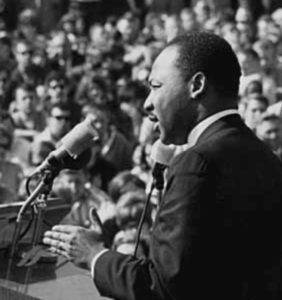
The answer is to go deeper than race, deeper than wealth, deeper than gender. To teach ourselves to comprehend each person, not as a symbol of a group, but as a unique and special individual within a common context of shared humanity. To go to that fundamental place where we are all simply mortal creatures, seeking to create order, beauty, family and connection to the world that — on its own — seems to bend too often towards randomness and entropy. 8
But what if randomness and entropy, or even worse, are the goal?
Noting that a common theme in CRT is that racial justice requires race-based remedies, CRT sympathizer Waterhouse argued that “King’s vision of law and justice based on procedural justice was incomplete — lacking an adequate vision of restorative justice.” 9
And what is restorative justice? As prominent CRT advocate Ibram X. Kendi, director of the Center for Antiracism at Boston University and author of “How to be an Antiracist,” has written, “The only remedy to past discrimination is present discrimination. The only remedy to present discrimination is future discrimination.” 10
This is in marked contrast to Chief Justice John Roberts’s majority opinion in the 2007 U.S. Supreme Court case Parents Involved in Community Schools v. Seattle School District No. 1. Roberts wrote, “the way to stop discrimination on the basis of race is to stop discriminating on the basis of race.” 11
CRT is a far cry from the desegregation efforts of the old Civil Rights Movement, because CRT is rooted in a past that is both radical and purposefully opaque.
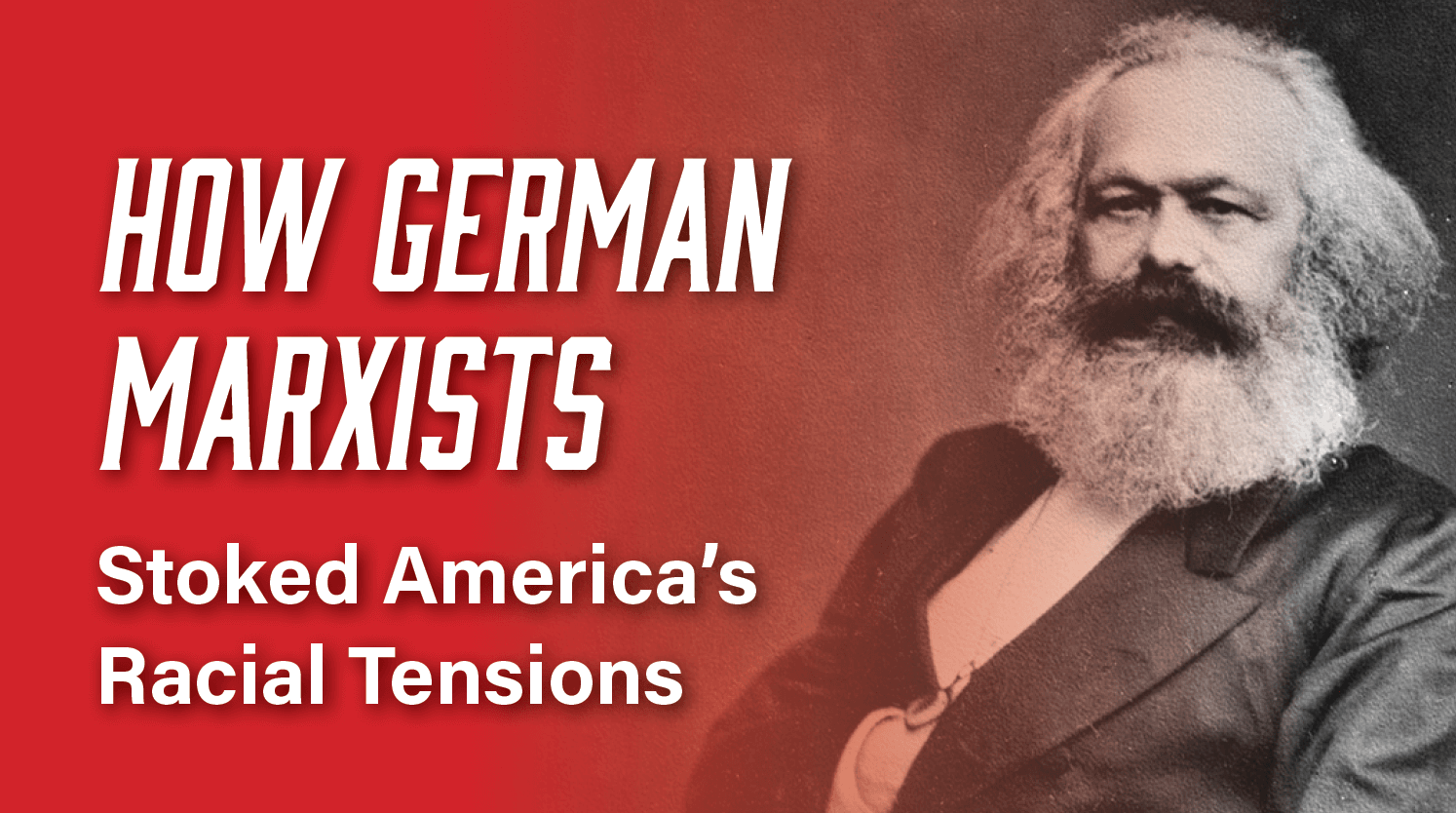
CRT is an outgrowth of critical theory, which was developed by academics affiliated with the Institute for Social Research at the Goethe University in Frankfurt, Germany. Originally intending to name the organization the Institute for Marxism, the Institute’s founders decided their project could be more effective under a more neutral-sounding name. “Thus began the Frankfurt School’s tradition of concealing its true nature and objectives,” notes cultural scholar William S. Lind. 12
Founded in 1923, the Frankfurt School hosted progressive scholars who were steeped in economic Marxism and who, over time, expanded their disavowal of capitalism to include a rejection of the culture they believed supported it.
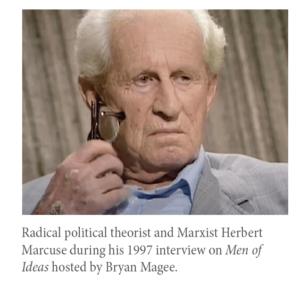 The think tank relocated to New York in 1934 to escape the Third Reich, a move that gave a wider audience to some of its most prominent figures, including Max Horkheimer, Theodor Adorno and Herbert Marcuse. (The Frankfurt School returned to Germany after World War II). Marcuse, who held teaching positions at Columbia, Harvard and the University of California at San Diego from 1952 to 1970, is popularly known as the “Father of the New Left.”
The think tank relocated to New York in 1934 to escape the Third Reich, a move that gave a wider audience to some of its most prominent figures, including Max Horkheimer, Theodor Adorno and Herbert Marcuse. (The Frankfurt School returned to Germany after World War II). Marcuse, who held teaching positions at Columbia, Harvard and the University of California at San Diego from 1952 to 1970, is popularly known as the “Father of the New Left.”
Marcuse’s contribution to CRT can best be seen in his 1965 essay, “Repressive Tolerance.” In that work, he claims that capitalist societies have totalitarian aspects and that genuine tolerance does not permit support for “repression.”
He characterizes tolerance for repressive speech as “inauthentic,” and advocates a form of tolerance that includes the “withdrawal of toleration of speech and assembly from groups and movements that promote aggressive policies, armaments, chauvinism, discrimination on the grounds of race and religion, or that oppose the extension of public services, social security, medical care, etc.” 13
Marcuse’s “withdrawal of tolerance” has thus laid the groundwork for the imposition of speech codes and other behavioral mandates that now comprise CRT policies.
The seeds planted by the Frankfurt School have taken time to bear fruit. The first signs that critical theory had transmogrified into critical race theory could be seen in legal studies programs influenced by Frankfurt School-inspired critical legal theory. These efforts were spearheaded by such progressive CRT voices as Derrick A. Bell, Jr., Kimberle Williams Crenshaw, Richard Delgado and Robin DiAngelo.
Founded in 1923, the Frankfurt School hosted progressive scholars who were steeped in economic Marxism and who, over time, expanded their disavowal of capitalism to include a rejection of the culture they believed supported it.
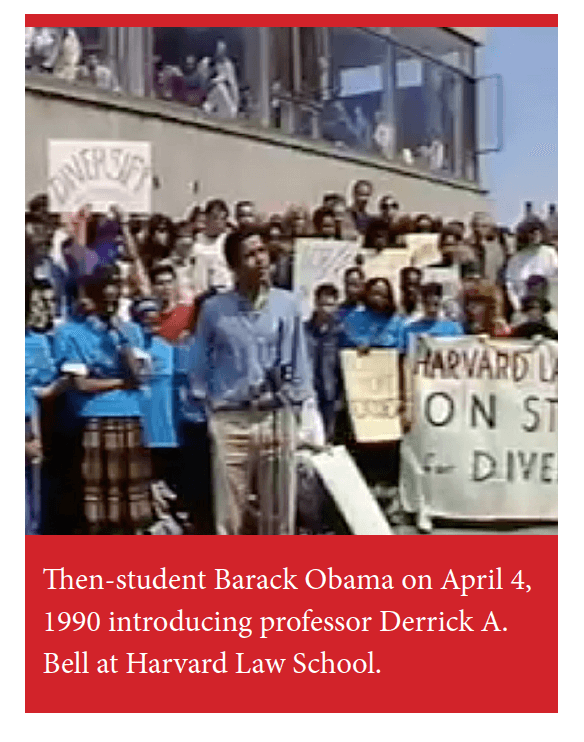
Marcuse’s “withdrawal of tolerance” has thus laid the groundwork for the imposition of speech codes and other behavioral mandates that now comprise CRT policies.
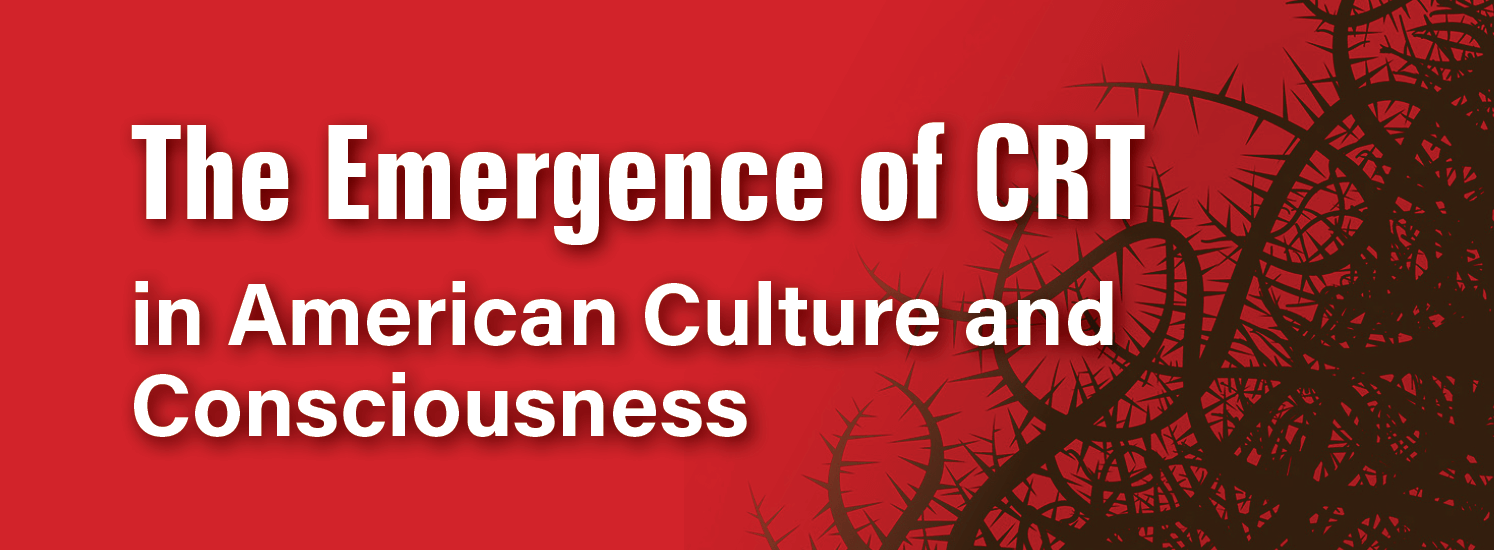
Initially confined to university classrooms and academic journals, CRT quietly burrowed its way into the consciousness of left-leaning activists, writers and public officials. It revealed itself publicly in the wake of the May 2020 death of George Floyd at the hands of Minneapolis police and in the resulting Black Lives Matter (BLM) protests.
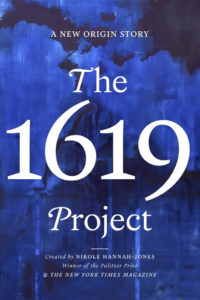 The growth of BLM followed on the heels of the August 2019 publication of “The 1619 Project“ in the New York Times Magazine. 14 Overseen by Nikole Hannah-Jones, the project traces the founding of the nation not to the adoption of the U.S. Constitution or even the Declaration of Independence, but to the arrival of the first African slaves in the colony of Virginia in 1619.
The growth of BLM followed on the heels of the August 2019 publication of “The 1619 Project“ in the New York Times Magazine. 14 Overseen by Nikole Hannah-Jones, the project traces the founding of the nation not to the adoption of the U.S. Constitution or even the Declaration of Independence, but to the arrival of the first African slaves in the colony of Virginia in 1619.
The 1619 Project’s collection of 30 essays and artistic productions was ultimately awarded a Pulitzer Prize, even though it presents radical theses such as the claim that America’s “founding ideals were false when they were written” and the idea that “nearly everything that made America exceptional grew out of slavery.” 15
Noted historians have also identified a host of factual misstatements and historical errors in the work. In one highly covered instance, five historians wrote to the Times to urge corrections, arguing that the 1619 Project was inaccurate and misleading regarding the motivations for the Revolutionary War and President Abraham Lincoln’s views on black equality. 16
With little to no historical support, the 1619 Project thrust slavery and its aftermath into the center of the American historical narrative. Lesson
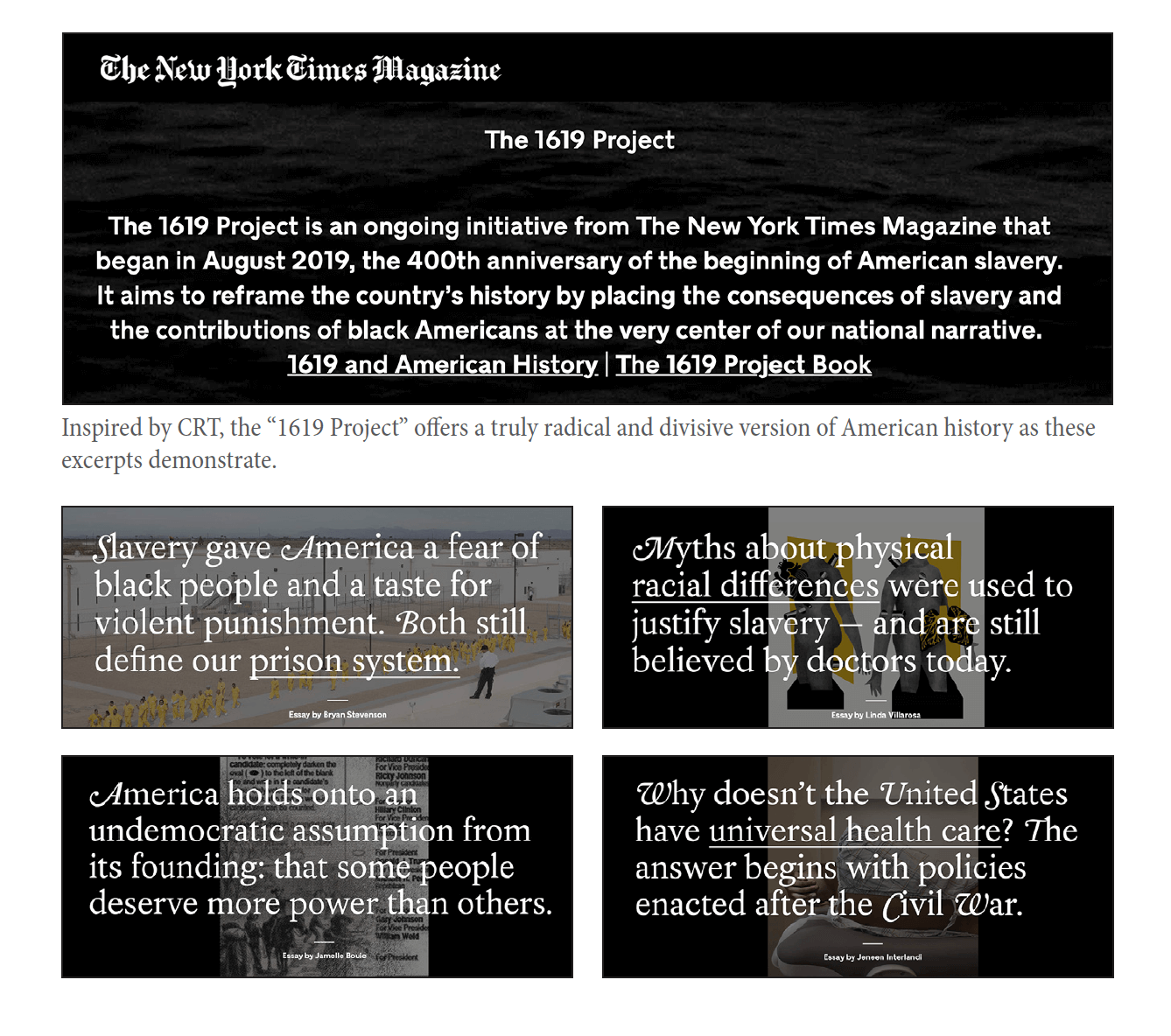
plans and children’s books have sought to further cement the Project’s claims — rooted in CRT’s race-based tenets — in the minds of the next generation. 17
Sadly, several American institutions have taken up the CRT banner. While the Times lent its stature to the specious claims of the 1619 Project, many other mainstream media outlets have promoted the overall aims of CRT and President Joe Biden’s administration has forcefully advocated for CRT-inspired policies. Corporate America has been inundated with liberal shareholder proposals pushing for board quotas and other race-based reports.
Yet in the face of this aggressive cancer, a small but vocal minority have stood athwart history yelling stop. In school board meetings, Parent Teacher Association (PTA) events and legislative sessions across the land, resistance has mushroomed against efforts to expose schoolchildren of all races to CRT dogma — including the imposition of race-based division of students in the classroom.

Exposure and Resistance:
The Masses Fight Back!
In Wellesley, Massachusetts, documents obtained through a public records request show that the Wellesley Public Schools system has used “affinity spaces that divide students and staff by race.”
These “affinity spaces,” according to documents obtained by the watchdog group Judicial Watch, were specifically designed “for specialized populations within the wider Faculty/Staff (i.e., ALANA, Admin Leaders of Color, LGBTQ+, White Educators for Antiracism, etc.).”
Wellesley’s schools, the documents reveal, have also adopted an “equity tool kit” that states: “Prejudice, bias, hate and discrimination remain threats that require our vigilance and persistence to ensure that our core values are adhered to, and our mission is realized. This is our work. Stand with us.” 18
Loudoun County, Virginia, a well-off multiracial exurban jurisdiction west of Washington, D.C., has found itself at the fulcrum of the culture war over CRT. In 2019, the county’s school system developed a 22-page “Plan to Combat Systemic Racism“ which, among other things, called for training teachers to foster “racial consciousness.”
School officials also adopted an “equity plan” which, while not officially adding CRT to the curriculum, uses “overlapping vocabulary” such as “white supremacy” and “systemic racism” to politicize the curriculum. 19 In raucous school board meetings, parents and board members have squared off over what was being proposed for the county’s K-12 classrooms.
One parent, Xi Van Fleet, said she grew up in China under tyrant Mao Zedong and was all too familiar with CRT’s Marxist roots. She told the board:
We are teaching our children to be social justice warriors and to loathe our country and our history. Growing up in China, all of this sounds very familiar. The communist regime used the same critical theory to divide people. The only difference is that they used class instead of race. This is indeed the American version of the Chinese cultural revolution. 20
CRT’s obsession with equity — equal outcomes at any cost — has triggered a controversy of similar ferocity in neighboring Fairfax County, Virginia. In a sign of how emotionally charged CRT-related issues have become, the Virginia PTA vowed to revoke the charter of a newly-created parent-teacher association chapter at Thomas Jefferson High School for Science and Technology. That chapter has challenged efforts to introduce race-based policies at the school, incurring the wrath of the state organization and county officials.
Ranked first among all public schools nationally, TJ — as it is known locally — has traditionally employed a tough admissions process that included a rigorous, race-blind examination. That changed in December 2020, when county officials seeking to create more racial balance on campus scrapped the competitive exam in favor of a more “holistic” admissions process that, among other things, put a cap on the number of students each middle school could send to TJ. This imposed a de facto limit on middle schools with a high number of Asian-American students. 21
The move had the desired effect: the percentage of Asian-American students fell from 73 percent in the 2019-2020 academic year to 54 percent for 2020-2021, while the number of black and Latino students increased. 22
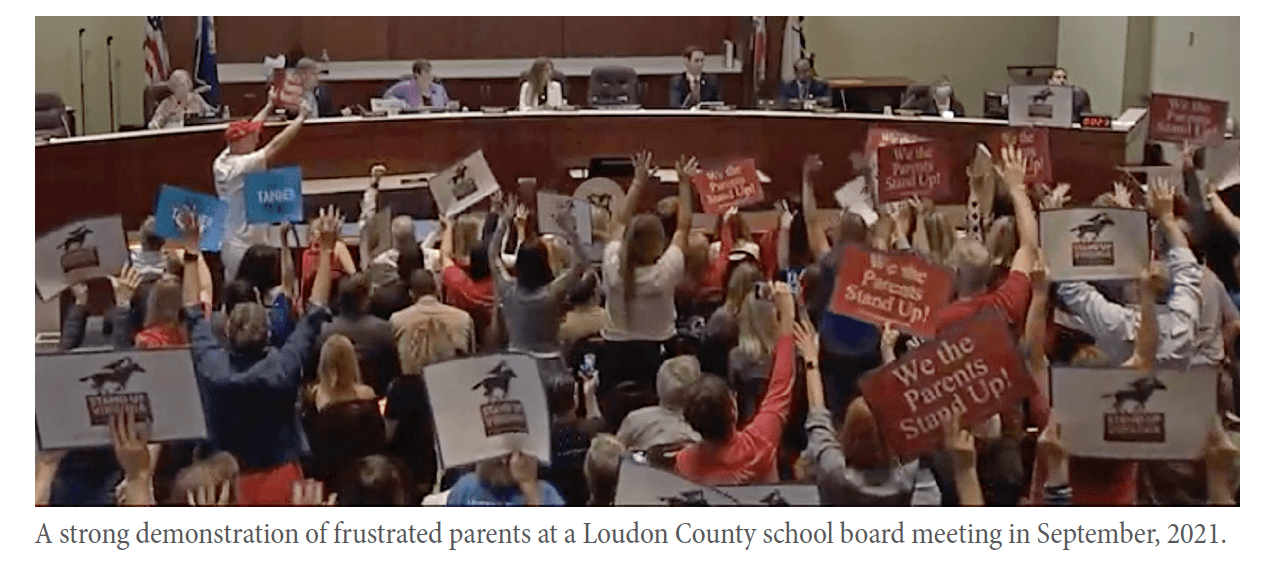
But the newly elected leadership of the TJ PTA wants to reinstate the color-blind entrance exam, a move opposed by county officials, the state PTA and the outgoing TJ PTA majority. The latter is aligned with the TJ Alumni Action Group, a pressure group dedicated to changing the “admissions process to be more equitable” and to “maintain[ing] the anti-racist curriculum,” according to the group’s website.
Harry Jackson, the incoming TJ PTA president, is black. He is a retired U.S. Navy officer whose son passed the old exam before entering TJ in 2021. In a Washington Post op-ed, Jackson explained his opposition to the race-based policies being imposed on the school:
When I see the effort to water down the admissions standards for TJ — and let’s be clear, that effort is largely led by paternalistic white liberals who are determined to “help” minority victims at any cost — I see it for what it is: a tacit admission that they don’t think Black and Hispanic students have what it takes to compete on merit. 23
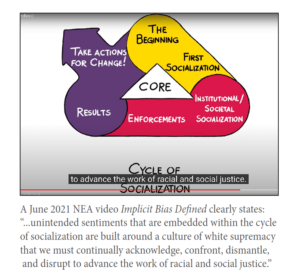 Meanwhile, a group of concerned parents called the Coalition for TJ has sued the school system, claiming the new race-based policy at TJ violates equal protection rights guaranteed by the 14th Amendment. In May 2021, a federal judge allowed the lawsuit to go forward. 24
Meanwhile, a group of concerned parents called the Coalition for TJ has sued the school system, claiming the new race-based policy at TJ violates equal protection rights guaranteed by the 14th Amendment. In May 2021, a federal judge allowed the lawsuit to go forward. 24
Idaho, Tennessee, Texas, Arkansas, Iowa and Oklahoma have all passed laws banning the teaching of CRT-related subject matter in schools, with similar legislation pending in several other states.25 In June, the Florida State Board of Education prohibited teaching that “racism is embedded in American society and its legal systems in order to uphold the supremacy of white persons.” 26 NBC News has counted 165 local and national groups opposing race- and gender-based school lessons. 27
For their part, those bent on racializing K-12 education are not about to give up the fight. In a July 6, 2021 speech, Randi Weingarten — the president of the 1.7-million-member American Federation of
Randi Weingarten, president of the American Federation of Teachers (AFT) falsely states CRT is not being taught to children in elementary or high schools and the national news media carried and promoted that narrative throughout the year.
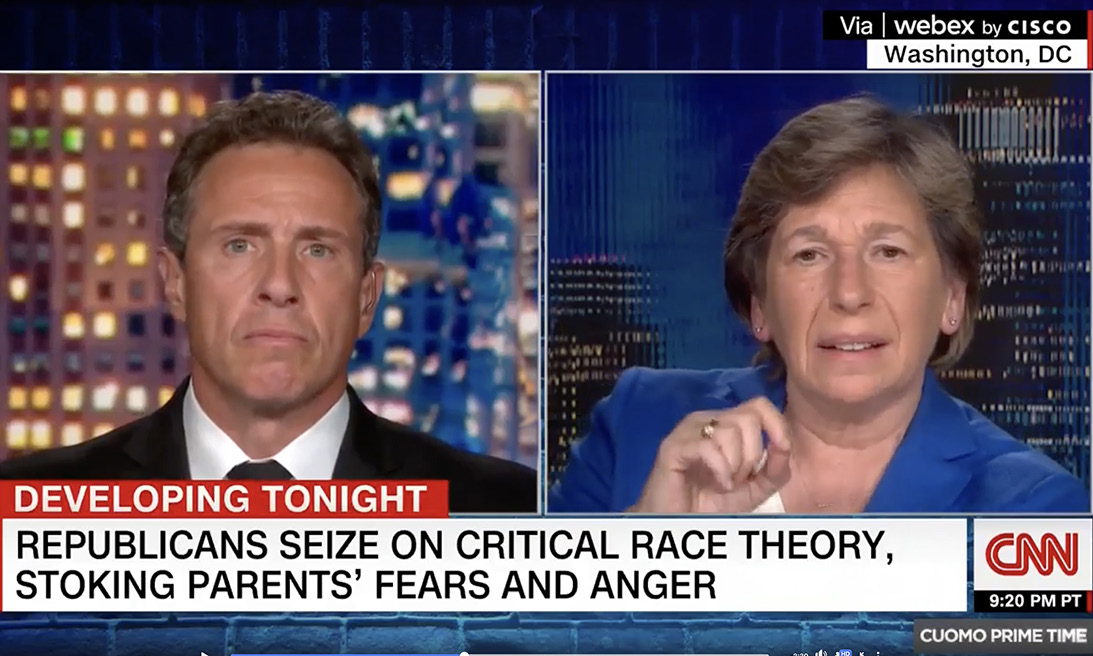
Teachers (AFT), the nation’s second-largest teachers union — said that conservative lawmakers, pundits and news sites were waging a “culture campaign” against critical race theory. Yet she also tried to deny that CRT is being taught to children. “Let’s be clear, critical race theory is not taught in elementary schools or high schools,” she claimed. “But culture warriors are labeling any discussion of race, racism or discrimination as CRT to make it toxic. They are bullying teachers and trying to stop us from teaching students accurate history.” 28
And despite her insistence that CRT is not being taught, Weingarten announced that the AFT was preparing litigation against states enacting anti-CRT laws.
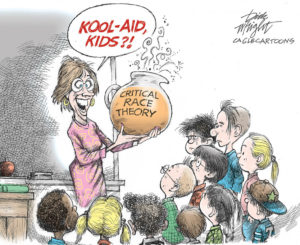 Denying that CRT is being taught while simultaneously promoting the dissemination of CRT-inspired lessons in the classroom is in keeping with CRT advocates’ deliberate obfuscation undertaken to hide the doctrine’s radical origins and mislead the public.
Denying that CRT is being taught while simultaneously promoting the dissemination of CRT-inspired lessons in the classroom is in keeping with CRT advocates’ deliberate obfuscation undertaken to hide the doctrine’s radical origins and mislead the public.
Weingarten’s remarks came shortly after the three-million-member National Education Association (NEA) adopted a resolution calling on its members to “fight back against anti-[critical race theory] rhetoric.” 29
As reported by the Washington Post, the resolution also declared that, in teaching subjects including social studies and history, “it is reasonable and appropriate for curriculum to be informed” by CRT tenets.

The Biden Administration is already taking steps to infuse critical race theory into the curriculum of the nation’s K-12 classrooms. This is being done through proposed U.S. Department of Education rules that would offer grants to subsidize the teaching of CRT as part of American history and civics courses.
The proposed rulemaking in the Federal Register states that the “ongoing national reckoning with systemic racism [has] highlighted the urgency of improving racial equity throughout our society, including our education system.” The proposal made favorable references to the New York Times’ 1619 Project and to CRT exponent Ibram X. Kendi. 30
In addition to creating a dedicated source of CRT grant money likely to grow over time, the Biden rules would, as the Heritage Foundation’s Lindsey Burke points out, “infuse critical race theory into the whole of the federal government’s primary governing law concerning K-12 schools, the Elementary and Secondary Education Act.” 31
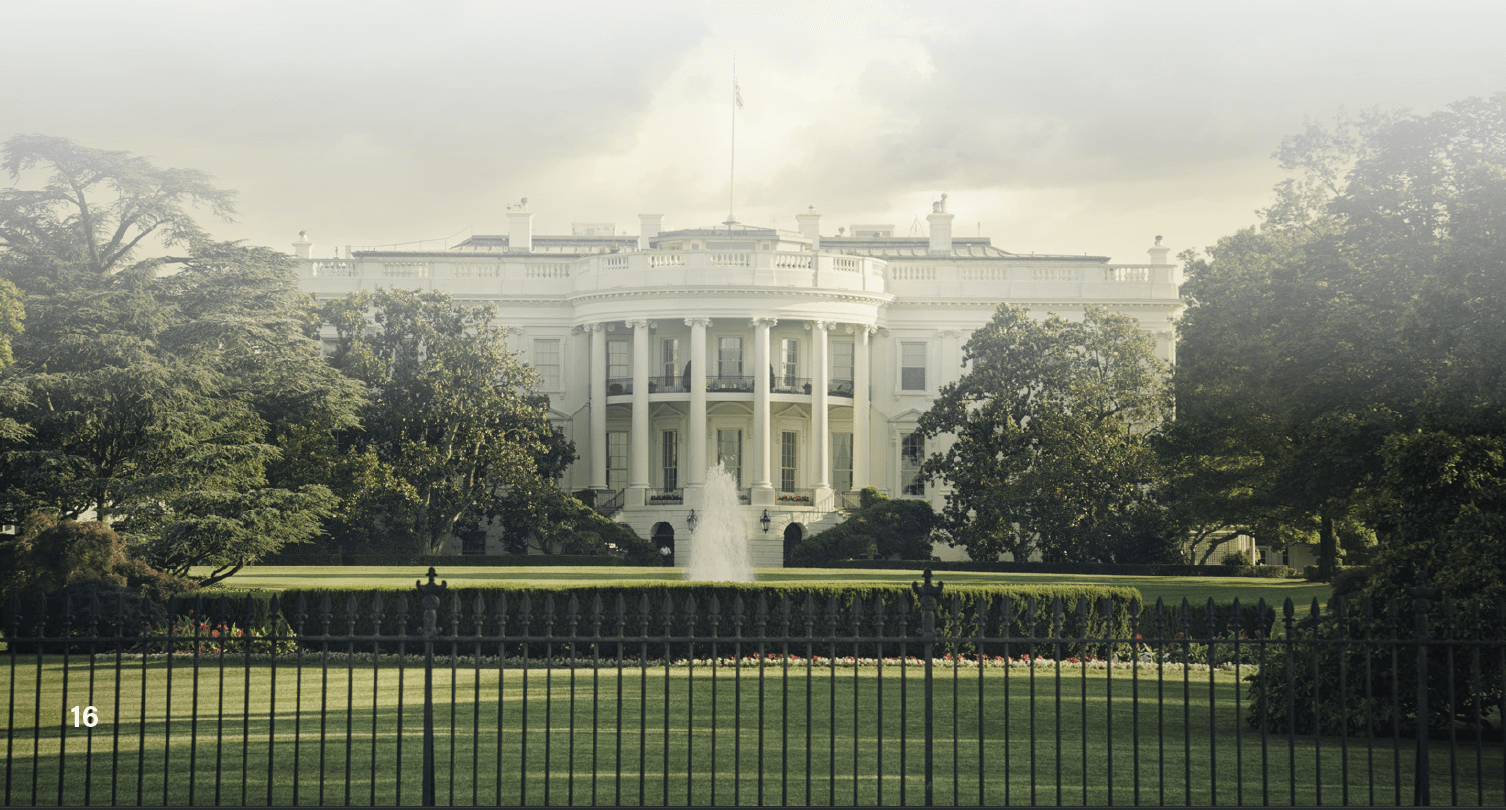
Over 35,000 public comments about the grant program were submitted to the U.S. Department of Education, and enough of them were negative to prompt the Biden Administration to make a few tactical linguistic adjustments in its description of the plan.
In a July 16, 2021 blog post, Education Secretary Miguel Cardona insisted the program did not dictate what should be taught in the classroom, but suggested it “encourages projects that incorporate racially, ethnically, culturally and linguistically diverse perspectives into teaching and learning.” 32
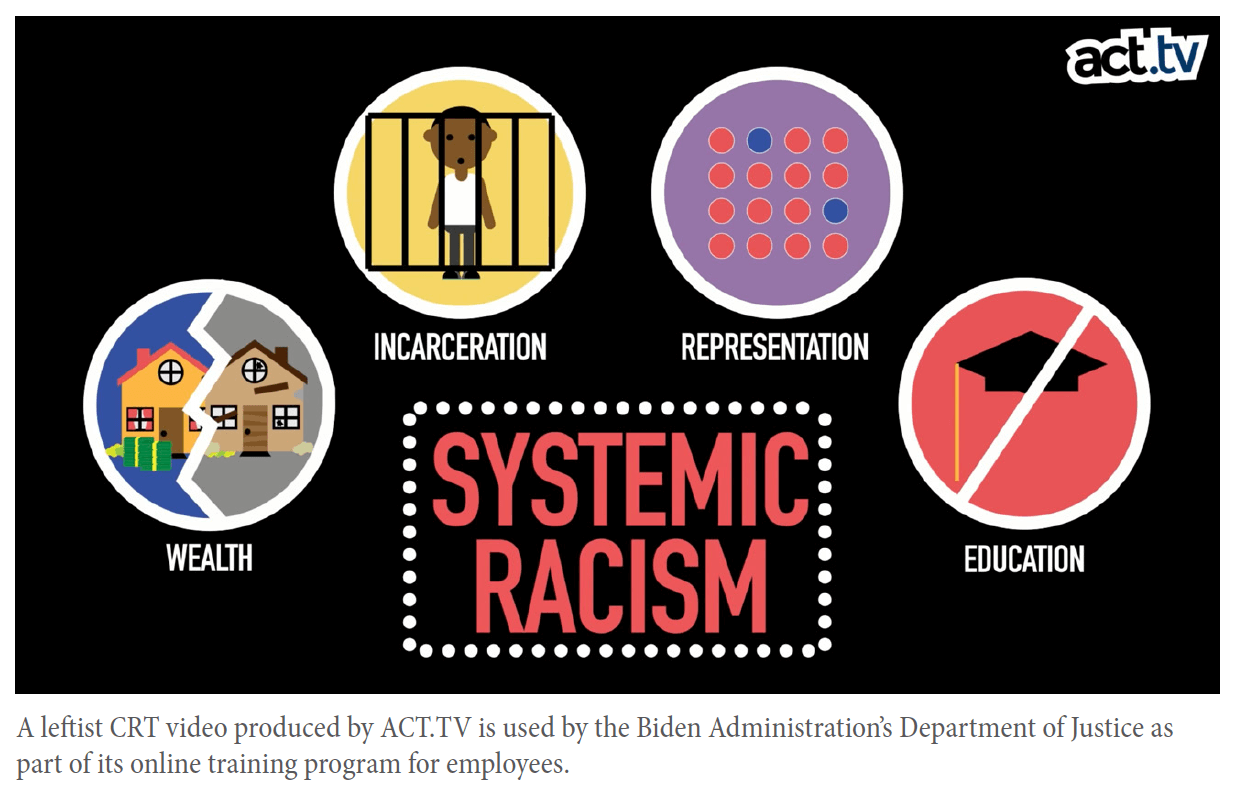
Cardona’s words were merely a rhetorical retreat, according to Stanley Kurtz, a senior fellow at the Ethics and Public Policy Center. “The preference for proposals built around ‘diversity’ is still clearly there,” Kurtz told The Federalist. “Cardona and the folks who run Biden’s education department are fully committed to CRT. President Biden has instructed every department to fight ‘systemic racism,’ making CRT the basis of administration policy. So this is nothing more than a shallow attempt to parry public criticism.” 33
CRT is also spreading to the private sector, with corporations and trade associations joining government agencies and universities in instituting their own “Diversity, Equity and Inclusion” (DEI) programs.
Raytheon Technologies Corporation, the nation’s second-largest defense contractor, for example, has adopted a CRT-inspired program called “Stronger Together.”

According to documents provided to investigative journalist Christopher Rufo by a whistleblower within the company, Raytheon’s employees are being encouraged to “becom[e] an anti-racist today.” CEO Greg Hayes expressed his support for the campaign by signing an “Action for Diversity & Inclusion” statement, pledging to “promote diversity” and “cultivate meaningful change for our society.” 34
Raytheon’s program, which is supported by several outside “diversity consultants,” includes a variety of lessons, workshops and charts. Employees are taught that the CRT doctrine of intersectionality will expose “interlocking systems of oppression” and “break down power into privilege and marginalization.” Whites are told that their level of discomfort is only “a fraction” of the emotional distress of their black colleagues, who are “exhausted, mentally drained, frustrated, stressed, barely sleeping, scared and overwhelmed.”
In keeping with these lessons, Raytheon executives are encouraged to segregate employees by race and identity into Employee Resource Groups (ERGs) for black, Hispanic, Asian, Native American, LGBTQ and other identities.
The goal of such groupings is ostensibly to “advance a culture of inclusion,” but such a division of the workforce is more likely to foster a culture of segregation and mutual distrust. Raytheon’s ERGs are the corporate equivalent of Wellesley Public Schools’ affinity spaces that segregate students and staff by race.
Disturbingly, the Raytheon curriculum depicts black Americans and other minorities as passive and helpless people who lack the resolve, skills and resourcefulness necessary to improve their situations. Such a perspective is inherently bigoted because it assumes that certain racial groups are either unable or unwilling to reach their full potential.
As offensive as Raytheon’s program has been, it pales in comparison to one offered by Coca-Cola. During one online DEI program, white Coca-Cola employees were instructed to “try to be less white” in order to fight racial discrimination. 35 This program created enough controversy for the company that, after the details were leaked to the public, Coca-Cola suspended the program and the company’s general counsel resigned.
Despite ongoing controversy and public opposition to CRT, the Biden Administration is doing its best to ensure that federal employees will be exposed to CRT-inspired indoctrination. On his first day in office, President Biden rescinded a July 2020 Trump Administration executive order banning race-based training sessions throughout the federal bureaucracy.
The goal of such groupings is ostensibly to “advance a culture of inclusion,” but such a division of the workforce is more likely to foster a culture of segregation and mutual distrust.
Not even the U.S. Armed Forces have been exempt from CRT-inspired indoctrination. 36 In February, the Navy released a recommended reading list to facilitate the “growth and development” of sailors. One of the books on the list was Kendi’s “How to be an Antiracist.” Separately, the Navy’s Second Fleet created a book club that included “White Fragility” by CRT-advocate Robin DiAngelo. In a National Review essay, U.S. Senator Tom Cotton points out that DiAngelo’s book “claims white people are inherently racist, whether consciously or subconsciously, and that race is the insidious subtext for virtually all human interactions.”
Given the military’s unique mission, any doctrine that undermines unit cohesion puts at peril not just the lives of those in uniform, but also the lives of the people they are sworn to protect. “Reductive, far-left
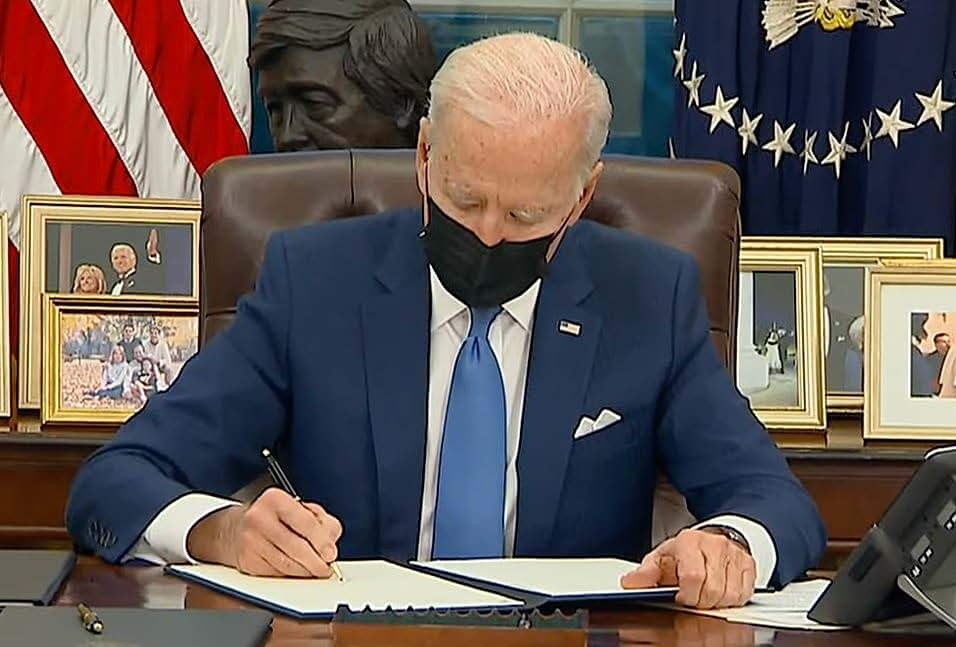
On his first day in office, President Biden rescinded a July 2020 Trump Administration executive order banning race-based training sessions throughout the federal bureaucracy.
theories of race are a mortal threat to this mission,” claims Cotton, who saw combat duty himself as an Army officer in Iraq and Afghanistan. 37
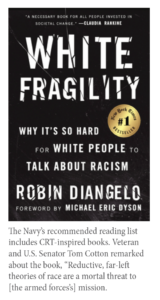 The Biden Administration has even invited other nations to criticize the United States on the issue of race relations. In May 2020, Secretary of State Antony Blinken invited representatives from the United Nations Human Rights Council to investigate “systemic racism” in the U.S. According to a Daily Caller report, one of the officials — Zambian-born law professor E. Tendayi Achiume — told U.S. politicians that America was “not exempt” from international obligations to eradicate racial discrimination, including reparations for slavery.
The Biden Administration has even invited other nations to criticize the United States on the issue of race relations. In May 2020, Secretary of State Antony Blinken invited representatives from the United Nations Human Rights Council to investigate “systemic racism” in the U.S. According to a Daily Caller report, one of the officials — Zambian-born law professor E. Tendayi Achiume — told U.S. politicians that America was “not exempt” from international obligations to eradicate racial discrimination, including reparations for slavery.
It should be noted that China, Cuba, the Russian Federation and several other countries with less-than-stellar human rights records are among the 15 members of the UN Human Rights Council. 38
Given the views of people like Achiume, it isn’t hard to imagine what conclusion the UN investigation will reach. By inviting such a probe, the Biden Administration has bestowed legitimacy on a race-driven Weltanschauung propagated by Frankfurt School-inspired tactics that undermine social cohesion in the finest Marxist tradition.
Thwarting the Marxist “long march through the institutions”
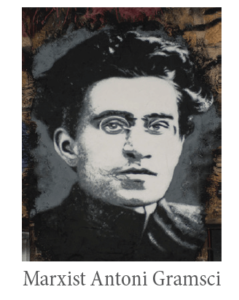 CRT also owes a debt of gratitude to the late Italian Marxist Antonio Gramsci, who once led the Communist Party of Italy and broke with traditional Marxist doctrines. Rather than trying to overthrow the capitalist system through a revolt of the proletariat, he sought the gradual transformation of bourgeois institutions that gave that system what he called “cultural hegemony.” This was to be accomplished through the “long march through the institutions.”
CRT also owes a debt of gratitude to the late Italian Marxist Antonio Gramsci, who once led the Communist Party of Italy and broke with traditional Marxist doctrines. Rather than trying to overthrow the capitalist system through a revolt of the proletariat, he sought the gradual transformation of bourgeois institutions that gave that system what he called “cultural hegemony.” This was to be accomplished through the “long march through the institutions.”
The long march called for infiltrating bourgeois institutions, infusing them with Marxist doctrine and transforming them into instruments of Marxism’s cultural hegemony. 39
What CRT is doing in schools, workplaces, the Armed Forces, the media and elsewhere in society has the potential to bring about a Gramscian transformation of the United States.
Those hoping for such a metamorphosis in America have tried to bring it about largely under the radar, desiring a fait accompli to emerge that would make resistance futile. But the growing backlash against CRT — one that encompasses a broad spectrum of the nation’s racial and ethnic groups — shows that the poison is being seen for what it is.

What Project 21 Believes
Those who make up the Project 21 black leadership network believe that the true objective of critical race theory is not to end racial inequality, but to exacerbate racial division solely to advance a Marxist agenda in an effort to radically transform our system of government and our nation as a whole.
We believe that expanding the power of government — as CRT theorists advocate — will make discrimination against minorities more likely, not less. Jim Crow laws, the Davis-Bacon Act and minimum wage laws 40 were designed to keep blacks out of the workforce — and these are, after all, institutions of government.
We believe treating all people equally under the law, rather than giving government-wide discretionary powers untethered from the law to remedy past discrimination as CRT advocates propose, is the best way to prevent discrimination.
We believe, as Dr. Martin Luther King, Jr. did, that people should be judged by the content of their character and not the color of their skin. The best way to promote racial reconciliation is by bringing people together and not by segregating them, as CRT theorists advocate.
We believe as King did that “group rights” degrade personality and are unjust.
We believe that the principle included in the Declaration of Independence “that all men are created equal” is a key reason for America’s success and also its global impact.
We believe that you cannot remedy past discrimination by simply discriminating against another group in the present. We agree with U.S. Supreme Court Chief Justice John Roberts when he said that “the way to stop discrimination on the basis of race is to stop discriminating on the basis of race.”
We believe that no governing philosophy has been more harmful to people of all races than Marxism. Stalin’s mass executions, China’s “Great Leap Forward,” Cambodia’s “Killing Fields” and famines resulting from Marxist central planning have killed some 100 million people. 41 CRT theorists advocate redistribution of private property, 42 a policy that had disastrous results in Zimbabwe 43 and Ethiopia. 44 Marxist mismanagement in Venezuela has condemned three-quarters of the population to extreme poverty, as hyperinflation and a lack of basic supplies and services has devastated the resource-rich country. 45
We believe Marxist regimes aren’t better in promoting equality but are actually much worse. China is currently holding over one million Muslim Uyghurs 46 in a network of reeducation camps where they are used as a source of slave labor. Cuba routinely discriminates against its black and mixed-race populace, with 71% of government jobs going to whites, despite blacks and mixed-race Cubans making up 62% of the population. In 2009, 70% of black Cubans were unemployed and 60% of them cited discrimination as the reason for their unemployment. 47 Cambodia’s Khmer Rouge exterminated an estimated 500,000 Cham Muslims – or about 70% of the total Cham population. 48 Joseph Stalin deliberately precipitated a famine in the Ukraine, killing an estimated 3.9 million of the East Slavic ethnic group. 49
And we believe there are few things that endanger continued black progress more than critical race theory. We believe it should be rejected by schools, by our government and by employers.
For a complete list of participants in Project 21, please visit: www.NationalCenter.org/Project-21

REFERENCES
1 Editors, Kimberlé Crenshaw’s Intersectional Feminism,” JSTOR Daily (Aug. 1, 2020), available at https://daily.jstor.org/kimberle-crenshaws-intersectional-feminism/ (last accessed Nov. 1, 2021).
2 John Stonestreet and Timothy T. Padgett, Critical Race Theory Conflicts with Christian Worldview, Arkansas Democrat Gazette (Feb. 20, 2021), available at https://www.arkansasonline.com/news/2021/feb/20/critical-race-theory-conflicts-with-christian/ (last accessed Nov. 1, 2021).
3 “I Have a Dream” Speech in its Entirety, NPR (Jan. 18, 2010), available at https://www.npr.org/2010/01/18/122701268/i-have-a-dream-speech-in-its-entirety (last accessed Nov. 1, 2021).
4 Carlton Waterhouse, Dr. King’s Speech: Surveying the Landscape of Law and Justice in the Speeches, Sermons, and Writings of Dr. Martin Luther King, Jr., Minnesota Journal of Law & Inequality (June 2012) (“Waterhouse, King’s Speech”), available at https://scholarship.law.umn.edu/cgi/viewcontent.cgi?article=1144&context=lawineq (last accessed Nov. 1, 2021).
5 Dr. Martin Luther King, Jr., We Have Come a Long, Long Way But We Still Have a Long, Long Way to Go, Speech at Southern Methodist University (Mar. 17, 1966), available at https://www.smu.edu/News/2014/mlk-at-smu-transcript-17march1966 (last accessed Nov. 1, 2021).
6 Ibid.
7 Waterhouse, King’s Speech, supra.
8 Wyatt Tee Walker and Steve Klinsky, A Light Shines in Harlem, Real Clear Politics (Sep. 24, 2015), available at https://www.realclearpolitics.com/articles/2015/09/24/a_light_shines_in_a_harlem_charter_school_128189.html (last accessed Nov. 1, 2021).
9 Waterhouse, King’s Speech, supra.
10 Ibram X. Kendi, Ibram X. Kendi Defines What it Means to be An Anti-Racist, Penguin Extracts (June 9, 2020), available at https://www.penguin.co.uk/articles/2020/june/ibram-x-kendi-definition-of-antiracist.html (last accessed Nov. 1, 2021).
11 Parents Involved in Community Schools v. Seattle School Dist. No. 1, 551 U.S. 701 (2007) (June 28, 2007), available at https://supreme.justia.com/cases/federal/us/551/701/ (last accessed Nov. 1, 2021).
12 William Lind, Cultural Marxism is Marxism, Chronicles (Nov. 2020), available at https://www.chroniclesmagazine.org/cultural-marxism-is-marxist/ (last accessed Nov. 1, 2021).
13 Herbert Marcuse, Repressive Tolerance (1969), available at https://www.marcuse.org/herbert/publications/1960s/1965-repressive-tolerance-fulltext.html (last accessed Nov. 1, 2021).
14 Leslie M. Harris, I Helped Fact-Check the 1619 Project. The Times Ignored Me, Politico (Mar. 6, 2020), available at https://www.politico.com/news/magazine/2020/03/06/1619-project-new-york-times-mistake-122248 (last accessed Nov. 1, 2021).
15 Nikole Hannah-Jones of the New York Times, Pulitzer Prizes (Aug. 14, 2019), available at https://www.pulitzer.org/winners/nikole-hannah-jones-new-york-times (last accessed Nov. 2, 2021).
16 Katie Mettler, Five Professors Say the 1619 Project Should be Amended. “We Disagree,” Says The New York Times, The Washington Post (Dec. 22, 2019), available at https://www.washingtonpost.com/history/2019/12/22/five-professors-say-project-should-be-amended-we-disagree-says-new-york-times/ (last accessed Nov. 2, 2021).
17 Naomi Schaefer Riley, “The 1619 Project” Enters American Classrooms, Education Next (May 28, 2020), available at https://www.educationnext.org/1619-project-enters-american-classrooms-adding-new-sizzle-slavery-significant-cost/ (last accessed Nov. 2, 2021).
18 James Varney, Schools’ Critical Race Theory Plans Could Violate the Constitution, State Laws, Says Watchdog Group, Washington Times (June 29, 2021), available at https://www.washingtontimes.com/news/2021/jun/29/watchdog-group-says-schools-critical-race-theory-p/ (last accessed Nov. 2, 2021).
19 Hannah Natanson, How and Why Loudoun County Became the Face of the Nation’s Culture Wars, The Washington Post (July 5, 2021), available at https://www.washingtonpost.com/local/education/loudoun-critical-race-theory-transgender-rights/2021/07/05/3dab01b8-d4eb-11eb-ae54-515e2f63d37d_story.html (last accessed Nov. 2, 2021).
20 Charles Creitz, VA Parent Who Survived Mao: Scholastic Critical Race Indoctrination “A Replay” of Mao’s “Cultural Revolution,” Fox News (June 11, 2021), available at https://www.foxnews.com/media/va-parent-survived-mao-critical-race-indoctrination-replay-maos-cultural-revolution (last accessed Nov. 2, 2021).
21 James Varney, Critical Race Theory at the Heart of Clash with Virginia PTA, Say Thomas Jefferson Parents, Washington Times (July 1, 2021), available at https://www.washingtontimes.com/news/2021/jul/1/critical-race-theory-heart-clash-virginia-pta-say-/ (last accessed Nov. 2, 2021).
22 Eric Wilcox, The Washington Post: The Purge of Asian American Students at Thomas Jefferson High School Has Begun, Pacific Legal Foundation (July 2, 2021), available at https://pacificlegal.org/the-washington-post-the-purge-of-asian-american-students-at-thomas-jefferson-high-school-has-begun/ (last accessed Nov. 2, 2021).
23 Harry Jackson, Thomas Jefferson High School Students and Parents are Fighting Changes to Admissions Standards. Here’s Why. The Washington Post (Mar. 10, 2021), available at https://www.washingtonpost.com/opinions/2021/03/10/thomas-jefferson-high-school-students-parents-are-fighting-changes-admissions-standards-heres-why/ (last accessed Nov. 2, 2021).
24 William McGurn, A PTA Purge of Asians, The Wall Street Journal (July 12, 2021), available at https://www.wsj.com/articles/a-pta-purge-of-asians-11626128073 (last accessed Nov. 2, 2021).
25 Anuli Ononye and Jackson Walker, The States Taking Steps to Ban Critical Race Theory, The Hill (June 9, 2021), available at https://thehill.com/homenews/state-watch/557571-the-states-taking-steps-to-ban-critical-race-theory (last accessed Nov. 2, 2021).
26 Bobby Caina Calvan, Florida Bans “Critical Race Theory” From its Classrooms, Associated Press (June 10, 2021), available at https://apnews.com/article/florida-race-and-ethnicity-government-and-politics-education-74d0af6c52c0009ec3fa3ee9955b0a8d (last accessed Nov. 2, 2021).
27 Terry Gross, Uncovering Who is Driving the Fight Against Critical Race Theory in Schools, NPR (June 24, 2021), available at https://www.npr.org/2021/06/24/1009839021/uncovering-who-is-driving-the-fight-against-critical-race-theory-in-schools (last accessed Nov. 2, 2021).
28 Emily Jacobs, Teachers Union President Defends Critical Race Theory as “Accurate History,” New York Post (July 8, 2021), available at https://nypost.com/2021/07/08/teachers-union-president-randi-weingarten-defends-critical-race-theory/ (last accessed Nov. 2, 2021).
29 Hannah Natanson, Amid Critical Race Theory Controversy, Teachers Union Chief Vows Legal Action to Defend Teaching of “Honest History,” Washington Post (July 6, 2021), available at https://www.washingtonpost.com/local/education/teachers-union-critical-race-theory-weingarten/2021/07/06/ef327c20-de61-11eb-9f54-7eee10b5fcd2_story.html (last accessed Nov. 2, 2021).
30 Proposed Priorities – American History and Civics Education, U.S. Department of Education (Apr. 19, 2021), available at https://www.federalregister.gov/documents/2021/04/19/2021-08068/proposed-priorities-american-history-and-civics-education (last accessed Nov. 2, 2021).
31 Lindsay Burke, “How Biden Aims to Take Critical Race Theory to the Next Level in Your School,” Daily Signal, May 15, 2021. (https://www.dailysignal.com/2021/05/15/how-biden-aims-to-take-critical-race-theory-to-the-next-level-in-your-school/ (last accessed Nov. 2, 2021).
32 Kery Murakami, Cardona Retreats From Making Critical Race Theory Part of New School Grants, Washington Times (July 16, 2021), available at https://www.washingtontimes.com/news/2021/jul/16/education-cardona-retreats-critical-race-theory-gr/ (last accessed Nov. 2, 2021).
33 Gabe Kaminsky, No, the Biden Administration is Not Backing Down on Critical Race Theory in Schools, The Federalist (July 21, 2021) (“Kaminsky, Not Backing Down”), available at https://thefederalist.com/2021/07/21/no-the-biden-administration-is-not-backing-down-on-critical-race-theory-in-schools/ (last accessed Nov. 2, 2021).
34 Christopher F. Rufo, The Woke Defense Contractor, City Journal (July 6, 2021), available at https://www.city-journal.org/raytheon-adopts-critical-race-theory (last accessed Nov. 2, 2021).
35 Bradford Betz, Coca-Cola Staff Told in Online Training Seminar “Try to be Less White,” Fox Business (Feb. 22, 2021), available at https://www.foxbusiness.com/lifestyle/coca-cola-staff-online-training-seminar-be-less-white (last accessed Nov. 2, 2021).
36 Kaminsky, Not Backing Down, supra.
37 Sen. Tom Cotton, There’s No Place in America’s Military for Racist Training, National Review (Apr. 1, 2021), available at https://www.nationalreview.com/2021/04/theres-no-place-in-americas-military-for-racist-training/ (last accessed Nov. 2, 2021).
38 Former Rep. Bob Barr, Biden Invites Left-Wing UN Group to Judge Racial and Human Rights Violations Within the US, Daily Caller (July 19, 2021), available at https://dailycaller.com/2021/07/19/barr-biden-left-wing-un-group-human-rights-violations-us/ (last accessed Nov. 2, 2021).
39 Mike Gonzalez, The Constitutional Way to Defeat Cancel Culture, The Heritage Foundation (Nov. 5, 2020), available at https://www.heritage.org/the-constitution/commentary/the-constitutional-way-defeat-cancel-culture (last accessed Nov. 2, 2021).
40 Project 21, Blueprint for a Better Deal for Black America, The National Center for Public Policy Research (May 2018), pg. 7, available at https://nationalcenter.org/project-21-blueprint-for-a-better-deal-for-black-america/ (last accessed Nov. 2, 2021).
41 Lee Edwards, We Must Never Forget the 100 Million Victims of Communism, Heritage Foundation (June 12, 2020), available at https://www.heritage.org/progressivism/commentary/we-must-never-forget-the-100-million-victims-communism (last accessed Nov. 2, 2021).
42 Christopher F. Rufo, What Critical Race Theory is Really About, The New York Post (May 6, 2021), available at https://nypost.com/2021/05/06/what-critical-race-theory-is-really-about/ (last accessed Nov. 2, 2021).
43 Craig J. Richardson, How the Loss of Property Rights Caused Zimbabwe’s Collapse, Cato Institute (Nov. 14, 2005), available at https://www.cato.org/economic-development-bulletin/how-loss-property-rights-caused-zimbabwes-collapse (last accessed Nov. 2, 2021).
44 Edwin Feulner, A Plan for Rescuing Starving Ethiopians, The Heritage Foundation (Dec. 27, 1984), available at https://www.heritage.org/node/22368/print-display (last accessed Nov. 2, 2021),
45 Venezuela Crisis: Three in Four in Extreme Poverty, Study Says, BBC News (Sep. 30, 2021), available at https://www.bbc.com/news/world-latin-america-58743253 (last accessed Nov. 2, 2021).
46 Who are the Uyghurs and Why is China Being Accused of Genocide?, BBC News (June 21, 2021), available at https://www.bbc.com/news/world-asia-china-22278037 (last accessed Nov. 2, 2021).
47 Terrell Jermaine Starr, Fidel Castro and Communism’s Flawed Record With Black People, The Washington Post (Dec. 5, 2016), available at https://www.washingtonpost.com/news/global-opinions/wp/2016/12/05/fidel-castro-and-communisms-flawed-record-with-black-people/ (last accessed Nov. 2, 2021).
48 Cambodia, University of Minnesota College of Liberal Arts: Holocaust and Genocide Studies, available at https://cla.umn.edu/chgs/holocaust-genocide-education/resource-guides/cambodia (last accessed Nov. 2, 2021).
49 Patrick J. Kiger, How Joseph Stalin Starved Millions in the Ukrainian Famine, History Channel (Apr. 16, 2019), available at https://www.history.com/news/ukrainian-famine-stalin (last accessed Nov. 2, 2021).




